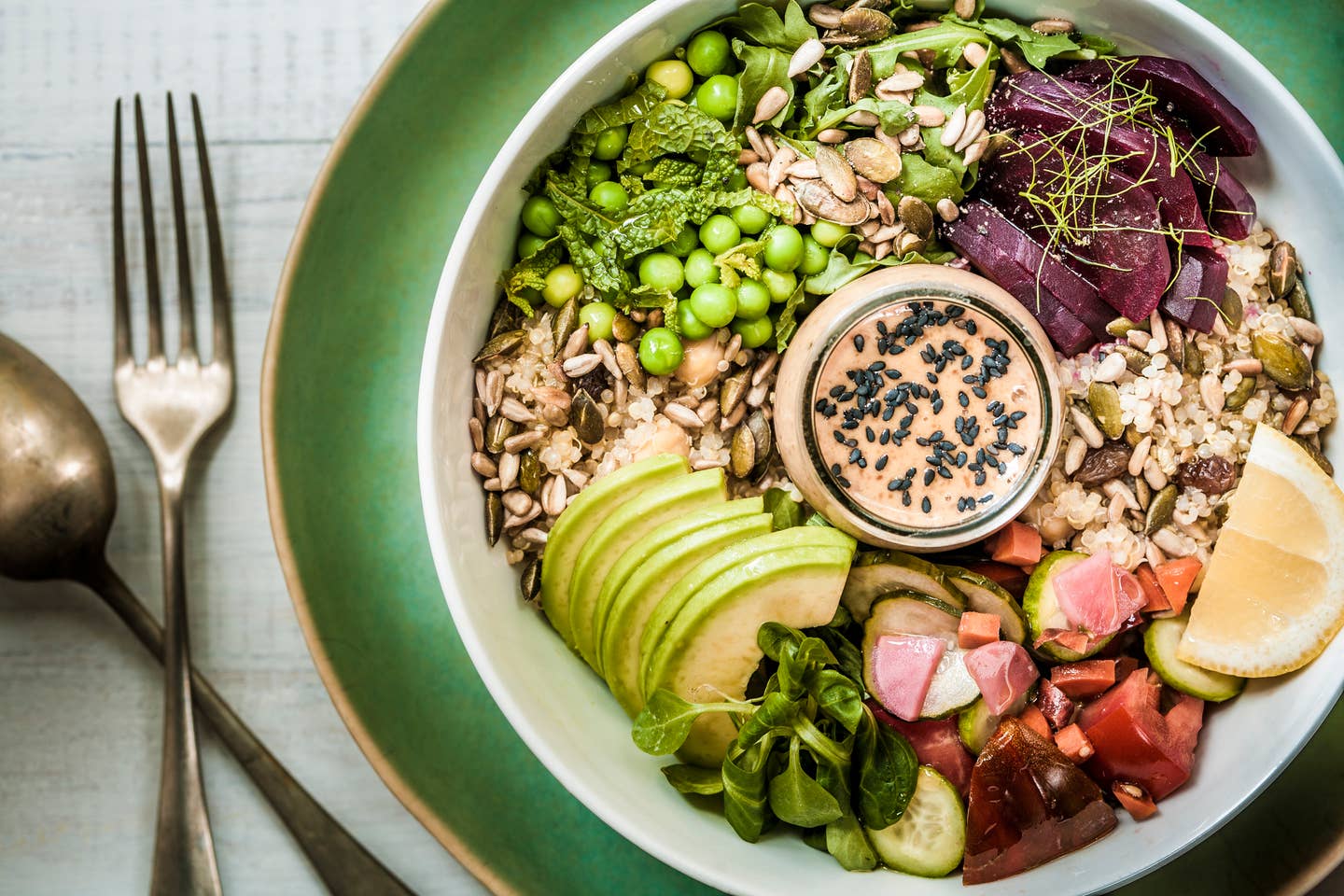
5 Plant-Based Foods You Can Add to Any Meal To Make It More Filling
Whenever I talk to people about switching to a plant-based diet, a concern that always comes up is fullness. “Will plant foods really fill me up?” “Don’t they have less protein than meat?” “Am I going to be hungry all the time?” The answers are straightforward (yes, yes, and no, for the record), but the questions are valid. Our bodies all have different needs based on our metabolisms, activity levels, and lifestyles, and what we eat plays a large role in satisfying (or not satisfying) those needs. We all want to feel comfortable and satiated after our meals. Fortunately, there are many plant-based foods we can eat to achieve that.
To bulk up any meal, we have to add protein, healthy fat, fiber, water, or a combination of these. Here are a few plant-based foods that do just that.
1. Pumpkin seeds
I’ll go out on a limb and say that pumpkin seeds are the dark horse of plant-based foods. They usually don’t make it on your grocery list unless they’re called for in a recipe, and they’re not the first food you think of, well, ever. And yet, they’re one of the most macronutrient balanced seeds at our disposal. One ounce of pumpkin seeds (aka pepitas) contains five grams of protein, five grams of fiber, and five grams of fat, making them far less fat-heavy than other nuts and seeds.
Their subtle flavor and satisfying texture allow pumpkin seeds to play nice with both savory and sweet dishes. They can be used to round out any salad, trail mix, or homemade granola, and garnish pasta, stews, or even tacos. I love using pepitas instead of pine nuts in herby pestos or sprinkling them atop fruit and dairy-free yogurt. With pumpkin seeds, you can’t take a wrong turn—any way you use them will be nothing short of delightful.
2. Nut or Seed Butter
Spreads are a deeply underappreciated category of food, especially when it comes to beefing up plant-based meals. Sure, we love the popular ones like hummus, peanut butter, and almond butter, but rarely do we think about expanding our horizons with spreads that are more unconventional. Other nut and seed butters are equally delicious and many of them pair well with savory dishes. I’m talking about tahini, sunflower seed butter, hemp seed butter, pumpkin seed(!) butter, walnut butter, and all the alternative seed butters out there. They even make watermelon seed butter now—something I never would have thought was possible.
All of these spreads contain impressive amounts of healthy fats, fiber, and protein—though some are higher or lower in each macronutrient than others. Next time you stroll down the peanut butter aisle, why not try something new? Spread any savory-leaning seed butter on your next sandwich, pile it high with veggies, add tofu or tempeh, and bask in the bliss of satiety. Or, check out these dips and dressings that utilize tahini. You’ve earned it.
3. Leafy Greens
While it’s true that greens don’t deliver much in the fat and protein departments (unless you eat a massive amount of them, which I can’t do, but be my guest), greens are the light, nutritious, fibrous friend that every plant-based meal needs. It also couldn’t be easier to work them into your diet. Whatever you eat, there’s a way to add a green. Eggs with spinach, grain salads with arugula, sandwiches with sprouts, soups with wilted kale, a side of roasted Swiss chard. Most greens don’t have overpowering flavor profiles (especially spinach), so half the time you won’t notice the difference taste-wise. But fullness-wise, eating greens is sure to please.
4. Hulled Hemp Seeds
Packed with protein and fat but low in carbohydrates, hulled hemp seeds (or hemp hearts) have a delicate crunch with an interior that’s smooth like butter. In terms of taste, I liken them to cashews—they’re not overwhelmingly nutty, but they don’t go unnoticed. Similar to pumpkin seeds, you aren’t going to add hemp seeds to something and come away saying it was a bad choice. Blend them into smoothies, toss a handful in your salad, or stir them into a dip for a little texture (a nut or seed spread, perhaps).
5. Water-Rich Vegetables and Fruits
Feeling full isn’t a numbers game—it’s a space game. We want to fill our stomachs with foods that are nutrient heavy and less calorically dense so we achieve the feeling of fullness without eating beyond our body’s needs. To do that, we need foods that are water-rich. Vegetables like cucumbers, lettuce, zucchini, celery, bell peppers, cauliflower, and cabbage have water contents of 92 percent or higher. Many fruits are water-logged as well, including watermelon, tomatoes, grapefruit, strawberries, peaches, and oranges. Staying hydrated is a key component of satiety—we often mistake thirst for hunger, after all—so it’s crucial to incorporate these fruits and vegetables into your plant-based meals.
Bottom line: Eating a plant-based diet doesn’t mean you have to subsist on lettuce and pretend you feel full all the time. There are numerous ways to supplement your meals and appease your appetite—and the healthiest way to do so is by adding more plant-based foods.
More From The Beet






